Accepted Scientific Name: Mammillaria schiedeana Ehrenb.
Allg. Gartenzeitung (Otto & Dietrich) 6: 249. 1838 Otto & A.Dietr.

Cactus schiedeanus (Mammillaria schiedeana) Photo by: Valentino Vallicelli
Origin and Habitat: Mammillaria schiedeanaSN|14012]]SN|2251]] is endemic to Mexico in the states of Guanajuato, Hidalgo, Querétaro, San Luis Potosí, and Tamaulipas. It has a restricted range (extent of eccurrence less than 20,000 km2)
Altitude: It occurs at elevations of 1,100 to 1,600 metres above sea level.
Habitat and Ecology: Mammillaria schiedeanaSN|2251]]SN|2251]] is is rare across its range and is found growing on limestone and rocky slopes in submontane matorral together with Gymnocactus horripilusSN|12124]]SN|12124]], Mammillaria geminispinaSN|2251]]SN|14012]], Astrophytum ornatumSN|3660]]SN|3660]], Tillandsia alba, Bursera morelensis, Ferocactus glaucescensSN|1532]]SN|1532]], Cephalocereus senilisSN|6893]]SN|6893]], Stenocereus dumortieriSN|8042]]SN|7942]], Stenocereus marginatusSN|7942]]SN|8042]], Myrtillocactus geometrizansSN|8050]]SN|8050]], Echinocactus platyacanthusSN|10367]]SN|10367]], Opuntia bergeriana, Opuntia tomentosaSN|8157]]SN|34821]], Opuntia atropes, Opuntia streptacantha, Opuntia imbricataSN|34821]]SN|8157]], Opuntia pumila and Agave angustifolia. This species is threatened by illegal overcollection for trade for use as an ornamental.
Synonyms:
See all synonyms of Mammillaria schiedeana
Description: Mammillaria schiedeanaSN|2251]]SN|2251]] is a slow growing attractive cespitose cactus, with short, closely interwoven, hairy spines. It is somewhat soft in texture. Three subspecies are recognized, the nominate subspecies, subspecies dumetorum (J.A.Purpus) D.R.Hunt and subspecies giselae (Mart.-Aval. & Glass) Lüthy.
Habit: It is solitary to densely caespitose. The size and shape of the stems is somewhat variable from small evenly flattened rounded tops merging together very low to the ground, to form even mounds with larger headed, separately standing stems.
Roots: Thick root.
Stem: Globular flattened, more or less rounded at the top, dark green, soft-fleshed, 2,5-10 cm tall 4 to 6 cm. thick.
Tubercles: Green, close together, terete, long and thin, tapering toward the tips, without latex, 6-10 mm long; axil with long bristle-like white or yellowish hairs protruding above the tubercles or absent.
Spines: Dimorphic with two distinct young and mature forms.
Spines of juvenile seedlings: Less than 20, all radials, pale yellowish-white, conspicuously plumose (feathery), gradually increasing in number as plant ages.
Spines in the upper part of flowering stems:
Radial spines: Very numerous (as many as 120) in several series, white to pale cream with yellowish bases, spreading, fine, bristle-like, puberulent, 2-5 mm long, tips hairlike.
Central spines: 6-10, raylike and addpressed against the radials, a little stouter, feathery, yellow that turn white.
Flowers: White to cream-coloured, 8-15 mm long; inner perianth segments white; filaments white, style cream-coloured; stigma lobes 4, short, obtuse.
Blooming season: It produces ring after ring of flowers throughout most of the winter.
Fruits: Red, narrow in late summer.
Seeds: Black.
Subspecies, varieties, forms and cultivars of plants belonging to the Mammillaria schiedeana group
Bibliography: Major references and further lectures
1) Curt Backeberg “Cactus Lexicon” Sterling Publishing Company, Incorporated, 1978
2) Edward F. Anderson (2001) “ The Cactus Family”.
3) Hiroshi Hirao “Colour encyclopaedia of cacti” Japan 1979 (Japanese language and script)
4) Willy Cullmann, Erich Götz (Dozent Dr.), Gerhard Gröner “The encyclopedia of cacti” Portland, OR: Timber Press, 1986
5) David Hunt, Nigel Taylor “The New Cactus Lexicon” DH Books, 2006
6) Fitz Maurice, W.A. & Fitz Maurice, B 2013. Mammillaria schiedeana. In: IUCN 2013. "IUCN Red List of Threatened Species." Version 2013.2. <www.iucnredlist.org>. Downloaded on 05 January 2014.
7) Nathaniel Lord Britton, Joseph Nelson Rose “Cactaceae: Descriptions and Illustrations of Plants of the Cactus Family” vol. 4 The Carnegie Institution of Washington, Washington 1923
8) Walther Haage "Cacti and succulents: a practical handbook" Dutton, 1963
9) John Pilbeam “Mammillaria: the cactus file handbook” Cirio Publishing Services Ltd Dec/30,/1999
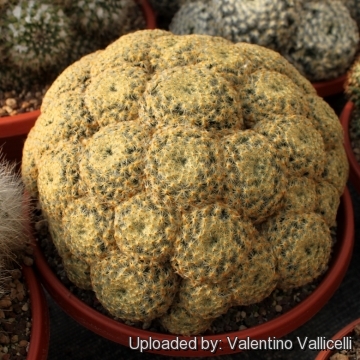 Cactus schiedeanus (Mammillaria schiedeana) Photo by: Valentino Vallicelli
Cactus schiedeanus (Mammillaria schiedeana) Photo by: Valentino Vallicelli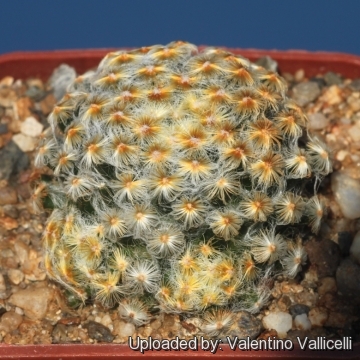 Cactus schiedeanus (Mammillaria schiedeana) Photo by: Valentino Vallicelli
Cactus schiedeanus (Mammillaria schiedeana) Photo by: Valentino Vallicelli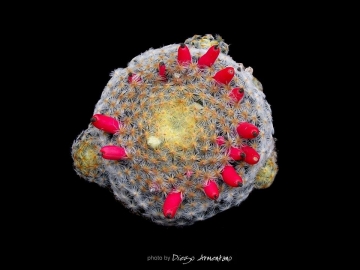 Cactus schiedeanus (Mammillaria schiedeana) Photo by: Diego Armentano
Cactus schiedeanus (Mammillaria schiedeana) Photo by: Diego Armentano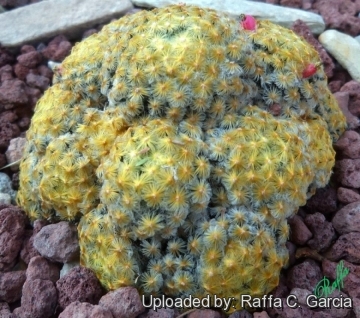 Cactus schiedeanus (Mammillaria schiedeana) Photo by: Raffa C. Garcia
Cactus schiedeanus (Mammillaria schiedeana) Photo by: Raffa C. Garcia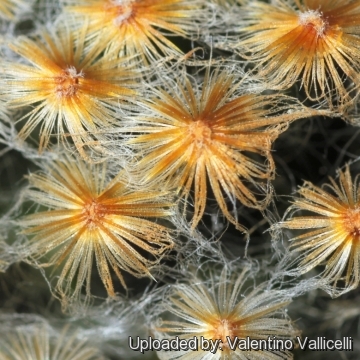 Cactus schiedeanus (Mammillaria schiedeana) Photo by: Valentino Vallicelli
Cactus schiedeanus (Mammillaria schiedeana) Photo by: Valentino Vallicelli Cactus schiedeanus (Mammillaria schiedeana) Photo by: Valentino Vallicelli
Cactus schiedeanus (Mammillaria schiedeana) Photo by: Valentino Vallicelli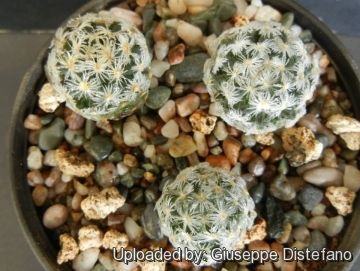 Cactus schiedeanus (Mammillaria schiedeana) Photo by: Giuseppe Distefano
Cactus schiedeanus (Mammillaria schiedeana) Photo by: Giuseppe Distefano Cactus schiedeanus (Mammillaria schiedeana) Photo by: Valentino Vallicelli
Cactus schiedeanus (Mammillaria schiedeana) Photo by: Valentino VallicelliCultivation and Propagation: Mammillaria schiedeanaSN|2251]]SN|2251]] is a slow growing species of relatively easy culture, recommended for any collection. If grown correctly, it will reward the grower with generous displays flowers.
Growth rate: It grows slowly in its natural habitat, but in greenhouses it grows more quickly. In cultivation it cluster after several years forming small mounds.
Watering: It is noticeably sensitive to excess moisture, as the roots are prone to rot. Water regularly in summer, but do not overwater. Let the soil dry out between watering. Keep dry in winter.
Soil: Use pot with good drainage and a very porous potting media.
Fertilization: Feed with a high potassium fertilizer in summer.
Hardiness: It is quite frost resistant if kept dry, hardy as low as -5° C (some reports give it hardy to -5°C)
Sun Exposure: High levels of light are needed to flower and for good spine development. Can be sunburned if moved from shade/greenhouse into full sun too quickly. During the spring it may be able to take full sun until the heat arrives at the end of spring. In an area that has hot afternoon sun, it may be able to take full morning sun, but requires afternoon shade or afternoon light shade.
Repotting: Re-pot in the spring when its roots become cramped. Generally, it should be re-potted every other year, in order to provide fresh soil. After re-potting, do not water for a week or more. For best results, use a shallow pot, and only use the smallest diameter pot that will accommodate the plant.
Propagation: Direct sow after last frost (usually) or division, wait until the offsets that appear at the base of old clustered specimens are 1/3 the size of the parent and then detach and plant. (Cuttings root quickly)
Your Photos
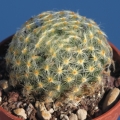
by Valentino Vallicelli
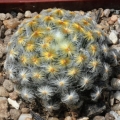
by Valentino Vallicelli
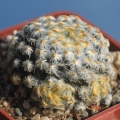
by Valentino Vallicelli






















